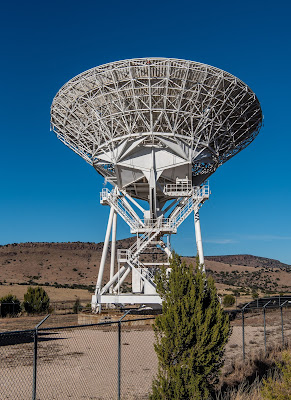I'll be the first to admit I had not heard of the McDonald Observatory which is just outside of Fort Davis. Built in the 1930's by the University of Texas and the University of Chicago, it is now operated as part of the University of Texas at Austin. Chris had stumbled on its existence when researching our trip in the area and though it would be a great place to visit, thus our staying at Fort Davis State Park, only about a 15 minute drive apart.
 |
| The Clouds Starting to Part as We Head Up |
 |
| Entrance Sign at McDonald Observatory with Telescope in Distance |
Next we headed on the little tour bus further up the mountain to see the Harlan J Smith telescope. At 107" diameter, it was the third largest in the world when build in the late 1960's. It is definitely big and an impressive instrument. Dan demonstrated how the floor can move up and down to help with maintenance and also moved the telescope in several different orientations. Next he moved the dome around to align the opening with the telescope. The only thing he could not do was actually open up the cover since the outside conditions were not right. In fact, the temperature in the observatory was being controlled to 41F the day we were there because that was the expected temperature for later that night when the dome would be opened and they wanted everything to be at equilibrium when the telescope was in use.
 |
| Harlan J Smith Telescope |
 |
| Our Tour Guide Dan Used A Wired Remote to Position Telescope |
 |
| Outside with Viewing Port Closed |
Even so, it was tough to comprehend since there is no tube around the optics. All the mirrors are mounted to a superstructure and visible to any visitors. This telescope was designed in such a way that it doesn't have as many degrees of freedom. Which means it cannot always point to all areas of the sky the other telescope can. So, unlike the first telescope on the tour where researchers actually come in and run the telescope during their allotted time slot, the HET is run by a group of local astronomers and technicians conducting experiments for researchers that never need to visit the facility.
 |
| HET and Its Unique Dome |
We drove around the area on our own which is permitted whether you paid for the tour or not. This allowed us to take pictures and see all the views the mountains provide. In fact the tour only got us into one area we couldn't get to on our own, but the tour was still well worth it and a highlight of the trip here. We decided the weather looked good to attend the star party tonight, but we had not dressed for an evening outside on top of the mountain. So we headed back to the campgrounds for dinner and warmer clothing. We stopped on our way to check out a huge radio telescope. It is part of ten located around the country monitoring the skies to eavesdrop on ET's phone call home, I suppose.
 |
| Incredible Views from Observatory Grounds |
 |
| Cactus in Bloom |
 |
| Harvard Radio Astronomy Station |
Before we left, I got out the tripod and camera and did some night shots, not of the skies since the moon was too bright, but did get some interesting ones of the smaller telescope domes.
 |
| Smaller Telescopes Used for Star Party |
 |
| Smaller Dome with Large Dome in Distance |
 |
| The Fort at Fort Davis from Above |
 |
| The Trail Signs Allow Intersting Shots |
No comments:
Post a Comment